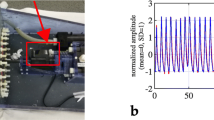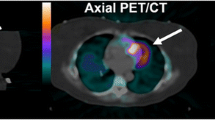Abstract
Objective
The aim of this study was to investigate the utility of gated PET/CT and CT attenuation correction (AC) for the quantitation of radioactivity.
Methods
An ellipse phantom containing six spheres, ranging from 10 to 37 mm in diameter, was filled with 36.7 kBq/mL of F-18. The respiratory motion was simulated by a motor-driven plastic platform to move the phantom with a displacement of 2 cm in the craniocaudal direction at a frequency of 15/min. With the phantom at rest, PET/CT data were acquired and used as a standard (nonmotion). With the phantom in motion, PET data were acquired in both the static and gated modes (sPET and gPET, respectively). Helical CT (HCT), slow CT (SCT), average CT (ACT), and four-dimensional CT (4DCT) were acquired and used to correct attenuation. On both PET and CT images, the maximum radioactivity, dimensions, and CT numbers were measured on the central slices.
Results
In nonmotion, recovery coefficients whose spheres were 22 mm or smaller gradually decreased. Regarding motion, the PET counts of the spheres in the static acquisition were lower than those acquired in nonmotion with either type of CTAC (sPET–HCT: −43.8%, sPET–SCT: −51.4%, sPET–ACT: −49.5%). Gated acquisition of PET significantly improved the PET counts (gPET–HCT: −30.1%) (p < 0.05), while additional gated acquisition of CT significantly improved them further (gPET–4DCT: −15.2%) (p < 0.01). The dimensions of sPET were overestimated, but those of gPET were close to the standard values. The SCT significantly overestimated the dimensions, and the water density area decreased (p < 0.01). The 4DCT images were similar to the HCT images.
Conclusions
In respiratory motion, PET acquisition in the static mode underestimated the radioactivity and overestimated the dimensions. Neither SCT nor ACT improved these errors. Although PET acquisition in the gated mode improved the quantification of PET/CT images, the additional gated CT acquisition using 4DCT is required for further improvement.






Similar content being viewed by others
References
Weber WA, Figlin R. Monitoring cancer treatment with PET/CT: does it make a difference? J Nucl Med. 2007;48:36–44.
Goerres GW, Kamel E, Heidelberg TN, Schwitter MR, Burger C, von Schulthess GK. PET–CT image co-registration in the thorax: influence of respiration. Eur J Nucl Med. 2002;29:351–60.
Cohade C, Osman M, Marshall LT, Wahl RN. PET–CT: accuracy of PET and CT spatial registration of lung lesions. Eur J Nucl Med Mol Imaging. 2003;30:721–6.
Erdi YE, Nehmeh SA, Pan T, Pevsner A, Rosenzweig KE, Mageras G, et al. The CT motion quantitation of lung lesions and its impact on PET-measured SUVs. J Nucl Med. 2004;45:1287–92.
Lagerwaard FJ, Van Sornsen de Koste JR, Nijssen-Visser MR, Schuchhard-Schipper RH, Oei SS, Munne A, et al. Multiple “slow” CT scans for incorporating lung tumor mobility in radiotherapy planning. Int J Radiat Oncol Biol Phys. 2001;51:932–7.
Nye JA, Esteves F, Votaw JR. Minimizing artifacts resulting from respiratory and cardiac motion by optimization of the transmission scan in cardiac PET/CT. Med Phys. 2007;34:1901–6.
Chi PC, Mawlawi O, Nehmeh SA, Erdi YE, Balter PA, Luo D, et al. Design of respiratory averaged CT for attenuation correction if the PET data from PET/CT. Med Phys. 2007;34:2039–47.
Nehmeh SA, Erdi YE, Ling CC, Rosenzweig KE, Squire OD, Braban LE, et al. Effect of respiratory gating on reducing lung motion artifacts in PET imaging of lung cancer. Med Phys. 2002;29:366–71.
Nehmeh SA, Erdi YE, Pan T, Yorke E, Mageras GS, Rosenzweig KE, et al. Quantitation of respiratory motion during 4D-PET/CT acquisition. Med Phys. 2004;31:1333–8.
Pan T, Lee TY, Rietzel E, Chen GT. 4D-CT imaging of a volume influenced by respiratory motion on multi-slice CT. Med Phys. 2004;31:333–40.
Pevsner A, Nehmeh SA, Humm JL, Mageras GS, Erdi YE. Effect of motion on tracer activity determination in CT attenuation corrected PET images: a lung phantom study. Med Phys. 2005;32:2358–62.
Okubo M, Nishimura Y, Nakamatsu K, Okumura M, Shibata T, Kanamori S, et al. Static and moving phantom studies for radiation treatment planning in a positron emission tomography and computed tomography (PET/CT) system. Ann Nucl Med. 2008;22:579–86.
Vines DC, Keller H, Hoisak JDP, Breen SL. Quantitative PET comparing gated with nongated acquisitions using a NEMA phantom with respiratory-simulated motion. J Nucl Med Technol. 2007;35:246–51.
Nagel CC, Bosmans G, Dekker AL, Ollers MC, Ruysscher DK, Lambin P, et al. Phased attenuation correction in respiratory correlated computed tomography/positron emitted tomography. Med Phys. 2006;33:1840–7.
Acknowledgments
The authors thank Mr. Hirofumi Kawakami (GE Healthcare Japan) and Mr. Naoyuki Tamamura (Nihon MediPhysics) for their technological assistance.
Author information
Authors and Affiliations
Corresponding author
Rights and permissions
About this article
Cite this article
Sakaguchi, Y., Mitsumoto, T., Zhang, T. et al. Importance of gated CT acquisition for the quantitative improvement of the gated PET/CT in moving phantom. Ann Nucl Med 24, 507–514 (2010). https://doi.org/10.1007/s12149-010-0388-4
Received:
Accepted:
Published:
Issue Date:
DOI: https://doi.org/10.1007/s12149-010-0388-4




